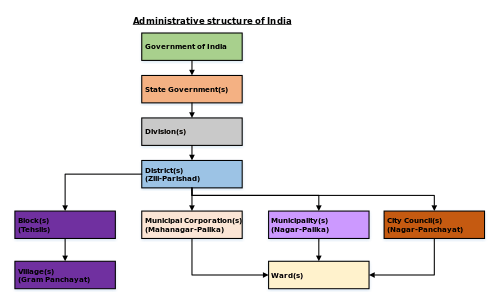Nagar parishad
 |
| This article is part of a series on the politics and government of India |
|
|
A nagar parishad or city council is a form of an urban political unit in India comparable to a municipality. An urban local body that administers with more than 15,000 and less than 25,000 inhabitants is classified as a "nagar panchayat" or "nagar parishad". Nagar parishad are also a form of local self-government, entrusted with some duties and responsibilities, as enshrined and guided upon by the Constitutional (74th Amendment) Act, 1992.
Constitution

Each nagar parishad has a committee consisting of a chairman/mayor with ward members. Membership consists of a minimum of 15-20 elected ward members and three nominated members. The N.A.C. members of the nagar parishad are elected from the several wards of the nagar parishad on the basis of adult franchise for a term of five years. There are seats reserved for Scheduled Castes, Scheduled Tribes, backward classes and women. The councillors or ward members chosen by direct election from electoral wards in the nagar parishad.
Administration
The chairman is the head of the Notified Area Committee. The executive officer is the official in charge of the Notified Area Council. Executive officers monitor the implementation of all the programs related to planning and development of the Notified Area Council with the coordination of N.A.C. chairman and all ward members.
Functions
- Provide essential services and facilities to the urban area.
- Sanitation programme in township.
- Street lighting and providing roads in every wards and main roads of town.
- Set up and run schools in urban area. Execute programme for adult literacy and run city libraries.
- Water supplying to every wards of urban area.
- Drainage system to clear the solid and liquid wastes from town.
- Build culvert for underground drainage system.
- Records of births and deaths
Sources of income
- Taxes on water, pilgrimage, markets, transport, etc.
- Fixed grant from the state government in proportion with the land revenue and money for works and schemes assigned to the nagar panchayat.